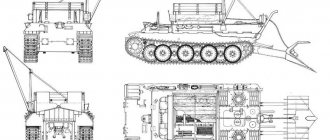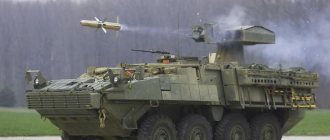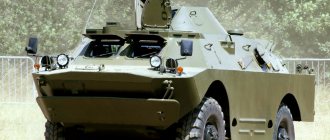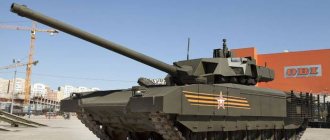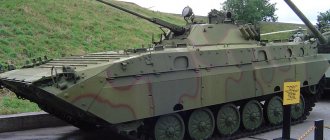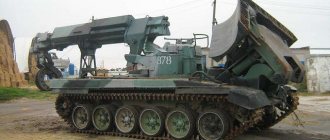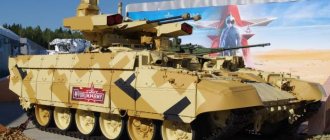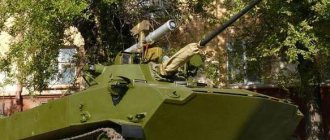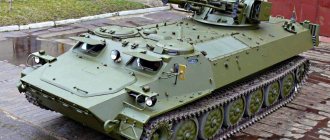| The article lacks references to sources. Information must be verifiable or it may be deleted. You can edit the article to add links to authoritative sources. This mark is set on April 16, 2022 . |
This term has other meanings, see BREM.
| BREM-L | |
| BREM-L | |
| Classification | armored recovery vehicle |
| Combat weight, t | 18,7 |
| Crew, people | 3 |
| Story | |
| Number of issued, pcs. | More than 85 |
| Dimensions | |
| Case length, mm | 7640 |
| Width, mm | 3150 |
| Height, mm | 2350 |
| Armament | |
| Machine guns | 1 x 7.62 mm PCT |
| Mobility | |
| engine's type | UTD-29, four-stroke, multi-fuel, liquid cooled |
| Engine power, l. With. | 450 |
| Highway speed, km/h | 70 |
| Speed over rough terrain, km/h | 9 afloat |
| Cruising range on the highway, km | 600 |
| Media files on Wikimedia Commons | |
Armored repair and recovery vehicle
(BREM-L) - designed for the evacuation of stuck and damaged light-weight equipment, armored personnel carriers, infantry fighting vehicles, infantry fighting vehicles, etc., including from under enemy fire. Provides necessary repairs and maintenance in the field.
BREM-L was developed on the basis of the BMP-3 infantry fighting vehicle at Kurganmashzavod.
Repair and recovery equipment[edit | edit code]
Jib crane installation, full rotation[edit | edit code]
- Drive type hydraulic, mechanical
- Load capacity, t 5 or 11 (when using a double chain hoist)
- Maximum boom radius, mm 4852
Mechanical traction winch[edit | edit code]
- Drive type: hydraulic
- Maximum traction force, kN (tf) 140—160 (14—16)
- Working length of cable, m 150
Bulldozer opener[edit | edit code]
used for securing the machine to the ground, performing excavation work and moving afloat
- Blade width, mm 3150
- Drive type: hydraulic
- Maximum depth, mm 340
Electric welding equipment[edit | edit code]
used for welding and cutting steel and aluminum alloys
- Welding method: semi-automatic electric arc, manual
Loading platform[edit | edit code]
all-metal, removable with folding right and rear sides
- Load capacity on land, t 1.7
- Loading capacity afloat, t 0.3
Performance characteristics of BREM-L Beglyanka
Crew, people: 3
Weight BREM-L Beglyanka
— 18.7 tons
Dimensions of BREM-L Beglyanka
— Body length, mm: 7640 — Body width, mm: 3150 — Height, mm: 2350 — Ground clearance, mm: 450
Armament BREM-L Beglyanka
— Machine gun 1 x 7.62 mm PKT
Engine BREM-L Beglyanka
— UTD-29T multi-fuel — Engine power, l. pp.: 450
Speed BREM-L Beglyanka
— Speed on the highway, km/h: 70 — Speed on the intersection. terrain, km/h: 9 afloat - Average towing speed, km/h: 20
Links
- T-44 · T-54 · T-55 · Object 416
·
Object 141
·
Object 139
·
Object 907
·
Object 140
·
Object 142
·
Object 430
·
Object 435
·
Object 167
· T-62 · T-62A ·
Object 920
· T-64
[/td]Medium tanks Heavy tanks IS-3 IS-4 IS-7 · T-10 ·
Object 266
·
Object 277
·
Object 278
·
Object 279
·
Object 770Missile tanks IT-1 · Item 64992 ·
Object 170
·
Object 431
·
Object 757
·
Object 772
·
Object 282
·
Object 906B
·
Object 775
·
Object 287
·
Object 780Flamethrower tanks OT-54 · Object 483 TO-55
BMPT Object 781 ·
Object 782
·
Object 787
· Object 199 "Frame"* ·
BMPT-72Main battle tanks T-62B · T-64A · T-64BV ·
Object 476
·
Object 172
·
Object 172-2M
· T-72 · T-72A · T-72B · T-72BA · T-72B3 · T-74 ·
T
-80 ·
T- 80A
·
Object 478
·
Object 785
·
Object 187
·
Object 477
·
Object 292
· T-80U · T-80UD · T-90 ·
T-90AM
·
Object 640
·
Object 195
·
T-14 (based on TSUP "Armata")ATGM combat vehicles 2P27 "Bumblebee" · 2P32 "Phalanx" · 9P19 "Eye" · 9P110 "Malyutka" · 9P122 "Malyutka-M" · 9P124 "Phalanga-M" · 9P133 "Malyutka-P" · 9P137 "Flute" · 9P148 "Konkurs" · 9P149 "Sturm-S" · 9P157 "Chrysanthemum-S" · 9P161 "Kornet-S" · 9P162 "Kornet-T"
Combat reconnaissance vehicles BRDM-1 Object 760 (“hover tank”) ·
BRDM-VPK
·
BRDM-VPS
·
Object 8M-906
· BRDM-2 · BRDM-3 · BRM-1K ·
BRM-2
· BRM-3K ·
BKM Airborne Forces "Vydra"
·
Patrol-AFlamethrower combat vehicles BMO-1 · BMO-T Armored personnel carriers K-75 · BTR-40 ·
BTR-112
·
K-78
· BTR-152 ·
ZIS-153
· BTR-50 ·
BTR-E152V
·
ZIL-153
·
GT-L
·
GT-LB
·
Object 1015
· BTR-60 · MT-
D
· BTR-70 · BTR-80 · BMM-80 · BTR-82 · BTR-90
·
BTR-T
· BTR-MD “Rakushka” ·
BMM-D
“ Boomerang " DT
-3PB
"
KrymskArmored vehicles Ural-4320-09-31 Ural-E4320D-31 Ural-E5323D GAZ-39344 ·
"Warrior"
·
"Bear"
·
Ural-6320
· "Typhoon" · ("Typhoon-U" ·
Ural-63099
· "Typhoon-K" ·
KAMAZ-63969
) · "Vodnik" · "Shot" · "Tiger" ·
"Wolf"
·
"Scorpion LTA"
·
"Bulat"
·
"Highlander-K"
·
"Federal-M" ("Stargazer")
·
"Scorpion LSA-B"ASU-76 ·
K-73
· SU-100P ·
SU-100M
· ASU-57 ·
BSU-11-57F
·
Object 574
· ASU-85 · SU-152
"Taran"
·
2S14 "Sting-S"
·
2S15 "Norov"
·
" Hermes"
· 2S25 "Sprut-SD" ·
2S28 "Sprut-K"
[/td]Anti-tank Self-propelled howitzers and mortars SU-152G ·
2A3 "Kondensator-2P"
·
2B1 "Oka"
·
Self-propelled guns with D-80
·
Self-propelled guns with D-80S
·
Self-propelled guns with D-80-2
· 2С1 "Gvozdika" ·
2С2 "Violet"
· 2С3 "Acacia" · 2С4 " Tulip" · 2S5 "Gyacinth-S" · 2S7 "Peony" ·
2S8 "Astra"
· 2S9 "Nona-S" ·
2S11 "Gyacinth-SK"
· 2S12B "Tundzha-Sani"* ·
2S17 "Nona-SV"
·
2S17 -2 "Nona-SV"
·
2S18 "Pat-S"
·
Object 327
· 2S19 "Msta-S" ·
2S21 "Msta-K"
·
2S22 "Flask-3"
·
"Compartment"
· 2S23 "Nona-SVK" · 2S24 "Virgo" ·
2S26 "Pat-K"
·
2S27 "Reef"
·
"Crimping"
·
2S30 "Iset"
· 2S31 "Vena" ·
2S33 "Msta-SM"
· 2S34 "Khosta" ·
2S35 "Coalition-SV"
·
Koalitsiya-SV-KSh
2S36
"Zauralets-D"Coastal A-222 "Bereg" BM MLRS and OTRK TZM 9T451 "Grad-1" · TZM "Grad-VD" · TZM-T “Solntsepek”
SPU SPU 2P2 "Mars" · SPU 2P4 "Filin" · SPU 2P5 "Korshun" · SPU 2P16 "Luna" ZSU-37-2 "Yenisei" ·
Object 130
[/td]37 mm 30 mm 2S6 "Tunguska" · 96K6 "Pantsir-S1" · ZPRK "Roman" ·
ZSU TKB-841 "Pantsir-S1-O"23 mm ZSU-23-4 "Shilka" BM air defense systems and air defense systems Strela-10 BM 9A35 SAM 9K35 "Strela-10-SV" Pine BM SAM "Sosna" Wasp BM 9A33B SAM 9K33 “Osa” Thor BM 9A330 SAM 9K330 “Tor” Cube SURN 1S91 SAM 2K12 "Kub" · SPU 2P25 SAM 2K12 "Kub" · SOU 9A38 SAM 2K12M4 "Kub-M4" Beech KP 9S470 SAM 9K37 "Buk" · SOC 9S18 SAM 9K37 "Buk" · SOU 9A310 SAM 9K37 "Buk" · PZU 9A39 SAM 9K37 "Buk" · RPN 9S36 SAM 9K317 "Buk-M2" Circle SOC 1S12 SAM 2K11 "Krug" · SNR 1S32 SAM 2K11 "Krug" · SPU 2P24 SAM 2K11 "Krug" S-300V KP 9S457 air defense system 9K81 "Antey-300" · radar 9S15 air defense system 9K81 "Antey-300" · radar 9S19 air defense system 9K81 "Antey-300" · MSNR 9С32 air defense system 9K81 "Antey-300" · PU 9А82 air defense system 9K81 "Antey-300" · PU 9A83 ZRS 9K81 "Antey-300" · ROM 9A84 ZRS 9K81 "Antey-300" · ROM 9A85 ZRS 9K81 "Antey-300" Cranes KT-15 · SPK-5 · SPK-12G BIS UR-67 · UR-77 · UR-88 ·
UR-93
· UR-07 · BMR-1 · BMR-2 · BMR-3 · BMR-3MIMR IMR-1 IMR-2 IMR-3 IMR-3M "Klin-1" AZM ·
ADZM "Vostorg-2"
· BAT-M · BAT-2RHM BRDM-2РХБ · РХМ · РХМ-2 · RKhM-3 · РХМ-4 · РХМ-5 · РХМ-6 · РХМ-7
BREM BREM-1 BREM-2 BREM-3 BREM-80U
BREM-L BREM-D BREM-K RM-GMTU MTU · MTU-20 · MTU-55 · MTU-72 · MTU-90 ICC MTP-1 · MTP-2 · MTP-3 · MTP-A5 Other SPU-117 · IRM · IPR · VTS · KDHR-1N · BTZ-3 · LKM-1 · LKM-3 · P-256G · RPM-2 · KhTV-64 · SPM
PRP and PPU PRP-3 "Val" · PRP-4 "Nard" · PRP-4M "Deuterium" · PPRU-1 "Gadfly-M-SV" · 9S482 (PU-12) · 9S482М6 (PU-12М6) · 9S737 "Rank" · 9S737M "Rangir-M" · 15Y56 (MBP) · "Palantin-P" KSAUO 1B13 1B14 1B15 1B16 Object 940 · 1В18 "Klen-1" · 1В19 "Klen-2" · 1В117 · 1В118 · 1В119 "Rheostat" · 1В152 · 1В157 · 1В21 · 1В22 · 1В23 · 1В24 · 1В25 · 1В31
Radar 1RL232 “Leopard” · SNAR-15 "Selenite" · 1RL239 “Lynx” · 1Л219 “Zoo”
electronic warfare 1L21 (SPR-1) 1L29 (SPR-2) 1K11 "Stiletto" ·
“Sanguine”
·
1K17 “Compression”* - produced only for export; italics Promising, experimental, or samples that did not go into mass production were identified
RemBat
Your humble servant at the stern of the ARV
BREM-1 is a wonderful car. In skillful hands it is simply magical. But... there is always a "BUT".
In the case of the BREM, there are several “BUTs”.
Based on its purpose, this car is primarily a tractor. Indeed, the presence on the BREM of a winch with a force of 25 tons and the ability to increase this force (by using chain hoists) up to 100 tons allows you to pull out tanks that are stuck up to the caterpillar shelf in the swamp, and then froze. The ARV pulls them out like irons along with a block of frozen soil and ice. The main thing is to find a good stop for the blade (the effort is no joke).
There have been many similar evacuation practices in my lifetime. He drove up, leaned on the blade, unwound the winch with the blocks, grabbed it, removed the people, turned on the winch, pulled it out... Everything was great. But this is where the first “but” begins:
BREM cannot drag (in the sense of towing) a modern tank over rough terrain
BREM-1 provides a parade on Red Square
terrain. In the park - maybe, on a flat road - maybe. It’s just not possible along a standard tank track with its ups and downs. And the point here, in general, is not that the engine does not pull. The engine is enough, as they say, with a reserve. Everything is simply simpler - the weight of the BREM-1 is much lighter than a tank. Of course, the tractor is based on the T-72. But of course it doesn’t have a turret or main armament. And it's lighter. And as a result, it doesn’t pull either the T-72 or the T-80 along the hillside road behind it. Slips on inclines. To be fair, it must be said that there is a constructive solution to this problem - this is the installation of additional lugs (included in the kit). But even in a pack, you get tired of putting them on a clean caterpillar, but in the field, in the mud, they’re generally a dead number. Traveling with them all the time isn’t easy either. The car turns worse, exploding the ground.
photo from my friend's archive
That’s why, when I went to “rescue” my track brothers stuck in the swamp, I took another tank with me. The task of the BREM is to winch the car - and that’s it. If the stuck car lost mobility, the tank towed it further. And the tractor simply returned in a convoy.
It is prohibited, except in extreme cases, to use a tank as a towing vehicle for a similar vehicle. But when I couldn’t “knock out” a tank for my mate, I had to suffer. Having reached the area where the ARV began to “grind” the soil, he unhooked the vehicle. The tractor drove forward, we unwound the winch, hooked it to the tank, pulled it to the crest of the next hillock and again hooked the tractor onto the towing ropes. Imagine how fun it was.
There is one more “BUT” associated with the operation of this machine in my practice:
After the millennium, vehicles with modifications began to enter service. Nothing fundamental was changed there; the car did not even add the “M” index to its name. But a number of improvements were still made. The most significant change is the installation of a new track. Moreover, previously the chassis (including the caterpillar track) of the BREM was absolutely identical to the T-72 tank, but now it has a completely different track. I'm not sure, but perhaps this track is installed on the latest versions of T-90 tanks.
This caterpillar is similar to the one on the T-80, with the difference that on the 80 its surface (the one on which the roller runs) is rubberized. The steel surface was also left here.
Having received this car for the first time, we were happy and decided that most likely the replacement of the caterpillar was done specifically to increase the vehicle's traction on the ground, and therefore improve towing characteristics. But the very first field experience refuted this opinion. In the end, we stopped racking our brains over this issue. The car is new, works perfectly, no complaints. But…
But then winter came. At first, winter operation didn’t give us any problems either, until I went on training exercises as part of a repair and evacuation group.
The deficiency that will be discussed may not appear throughout the entire winter; for its occurrence, a narrow climatic framework, so to speak, is necessary.
These frameworks are as follows: when the air temperature fluctuates around zero, but the snow has not yet turned into porridge and, on the one hand, retains the ability to crumble, and on the other hand, it is very easy to sculpt. Children love this weather very much. It's time for snowball fights.
So this is what happens to the BREM chassis (on a new track) in such weather. When driving on rough terrain (not on a compacted track), after the tracks push through the snow, a certain amount of this snow gets onto the caterpillar track from the edges. It would seem that it’s a common thing, if you hit it, it’ll fly out. But what happens next? The inner surface of the tracks is smooth and flat, and the road wheels, running over them, roll a dense layer of this snow and ice onto the track. And then this layer wraps around the drive wheel. The wheel becomes overgrown with a lump of snow, just as a child grows a lump when making a snowman.
The first time this happened, I didn’t believe my feelings. I was behind the levers myself (I loved this job), the car was moving alone (without a tow) and suddenly the engine began to sag as if the load on it had increased. After 100 meters it only got worse: the engine doesn’t pull at all. I stopped the tractor, got off the armor and couldn’t believe my eyes.
I saw exactly what you can see in the photograph. We had to get crowbars, it took about twenty minutes to clean both drive wheels, then we continued moving. but the same thing happened again no more than 1 km later. And so on until the camp itself. More precisely, to the road, after leaving which the “snowman effect” disappeared.
This was repeated further in my practice. But, as I wrote above, this only happens when a certain temperature and humidity of the snow coincide.
I think when this caterpillar was tested at the factory, they did not encounter such “weather conditions”.
Notes
- The Military Balance 2012. - P. 194.
- [vpk.name/news/62763_reiting_10_naibolee_znachimyih_postavochnyih_programm_i_eksportnyih_kontraktov_rossii_po_itogam_2011_goda_v_segmente_vooruzhenii_sv.html Rating of the 10 most significant supply programs and export contracts of Russia based on the results of 2011 year in the SV weapons segment] (Russian). Retrieved June 15, 2013. [www.webcitation.org/6HPJtC980 Archived from the original on June 16, 2013].
- The Military Balance 2012. - P. 353.

